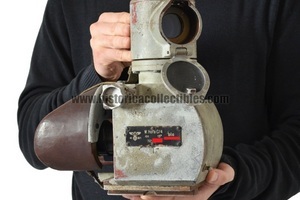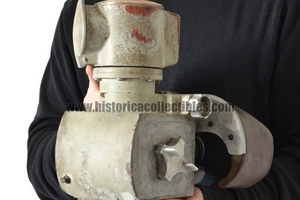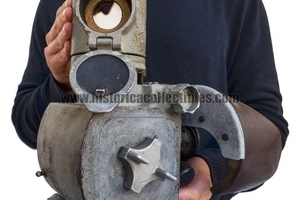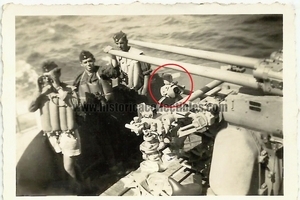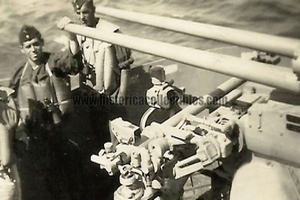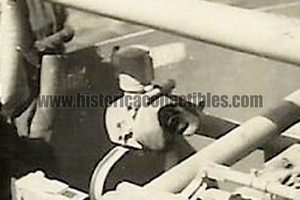Winkel-Horizontierfernrohr C/4, 4x 15°, BLC (Carl Zeiss) W. Hofe C/4, Kriegsmarine, 1941
Winkel-Horizontierfernrohr C/4 - W. Hofe meaning (Winkel Horizontier Fernrohr), or: Aiming sight and horizontal leveling of twin 3.7 cm cannons, installed on board Kriegsmarine ships, made entirely of bronze by BLC (Carl Zeiss), circa 1941.
The use of this periscopic sight with a rotating turret was necessary for the orientation and positioning of the guns with respect to the horizon line: in fact, by means of a particular reticle, which indicated the true angle of the horizon, the observer facilitated the the shooting direction's task is to position the guns on the target with extreme precision. The operator was able to manually rotate the periscope's rotating turret so that it could cover 180° of viewing surface (i.e. the entire side of the ship).
It is equipped with 4 magnifications, with a field of view of 15°, 262.5 meters can be observed at a distance of 1000 meters.
Its lenses feature the "T" (Transparenzbelag) anti-reflective treatment. By rotating the knob on the left, you can insert three filters (1 yellow for fog, 1 orange for definition even in low light and 1 neutral density). There is a removable forehead visor, which can be inserted into the designated housing, right or left, according to the operator's view and thus be able to have a correct vision.
The view is perfectly clear. All mechanisms work smoothly and correctly. Its weight is 5.5 kg.
CARL ZEISS Archiv:
The angle horizontal telescope C/4 is a vertical telescope (all-round telescope). The leveling telescope is used to approach the chine when leveling (stabilizing) ship equipment. With the viewing port fixed, the viewing head of the leveling telescope can be switched in three mutually perpendicular directions (straight ahead, left, right) as required. The optical values of the angle leveling telescope C/4 are magnification 4x, field of view 15°, diameter of the exit pupil 5.7 mm. The weight of the device is 5.3 kg.
Carl Zeiss takes its name from its founder, Carl Zeiss, who on November 17, 1846 chose the small city of Jena, in Thuringia, as the location for his precision optical equipment factory. Thanks to the strict quality control that Carl Zeiss imposed on its products, going so far as to personally destroy the microscopes that did not pass the tests, the newborn Zeiss became the official supplier of the University of Jena and received the gold medal of the industrial exhibition in 1861 of Thuringia as the best research instrument produced in Germany, awarded to the Stand I microscope of 1857.
In 1866 the thousandth microscope was produced and the name Zeiss became known throughout European scientific circles. Thanks to studies on the Porro prism, in 1893 Abbe patented double prism binoculars, which accentuated the perception of depth. The mass production of Zeiss binoculars began in 1894, already at the beginning of the twentieth century more than 30,000 were made, by the beginning of the First World War the figure had risen to 500,000 and, by the end of the Second World War, 2,260,000 were produced binoculars for the civil and military market. Models were made starting from 4x11 mm to 12x40 mm, up to real giants such as the 80 mm and 100 mm. Thanks to studies conducted on the perception of light in low light situations, it was shown that the average dilation of the pupil in an adult is about 7 mm. For this reason, the 7x50 mm model was introduced in 1910 and remained on the market until 1917 with few changes to the materials used.
In 1926, following the post-war crisis of the First World War with the Treaty of Versailles which bankrupted many important German companies, Zeiss bought the "C.P. GOERZ" and founded the Zeiss Ikon in 1926. In 1937 Zeiss had commercial contacts and factories in more than 29 countries around the world. From '33 Zeiss acquired interest from the Nazi regime, which balanced production towards military instruments. It successfully produced binoculars with wide-angle optics for military use, pressure resistant optical systems for U-boats, periscope binoculars for targeting tanks. Furthermore, Zeiss cameras were mounted on the V2s for remote sensing operations of the English coasts.
On November 1, 1935, Zeiss, in the person of Alexander Smakula, patented a process for the treatment of optical glasses with extraordinary results in terms of light transmission. Remained a military secret until 1939, it was adopted on binoculars to reduce ghost images and internal reflections. During the Second World War, there were numerous bombings against the Zeiss factories. Jena was bombed several times by the Allies starting in 1944. Stuttgart was razed to the ground, although the Contessa-Nettel factory suffered little damage. The bombing of Dresden, in addition to devastating the city, also caused considerable damage to the Zeiss Ikon headquarters.
On April 13, 1945, American military forces entered Jena, surprising themselves that the bombing had not caused any significant damage. The main planetarium was in ruins, while the factories remained operational.

